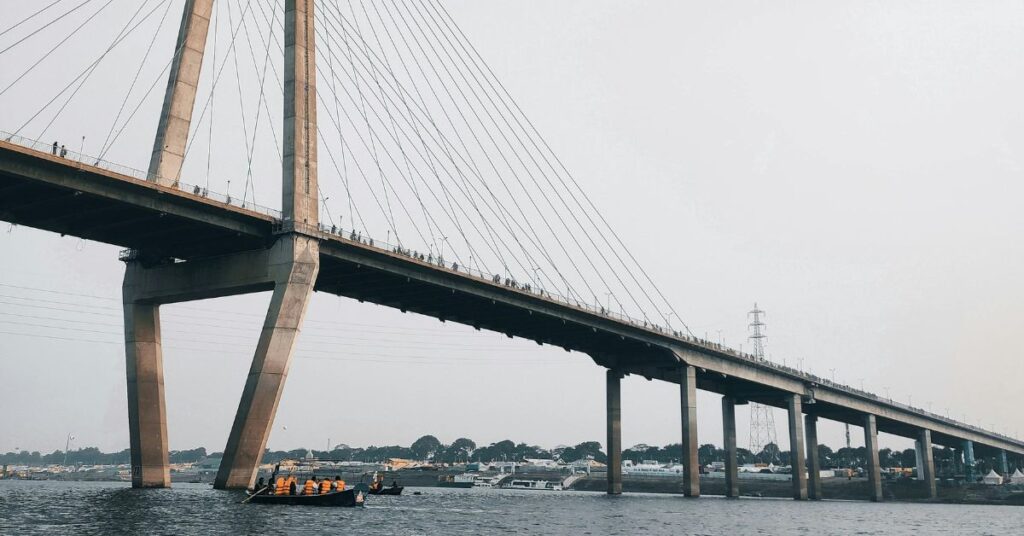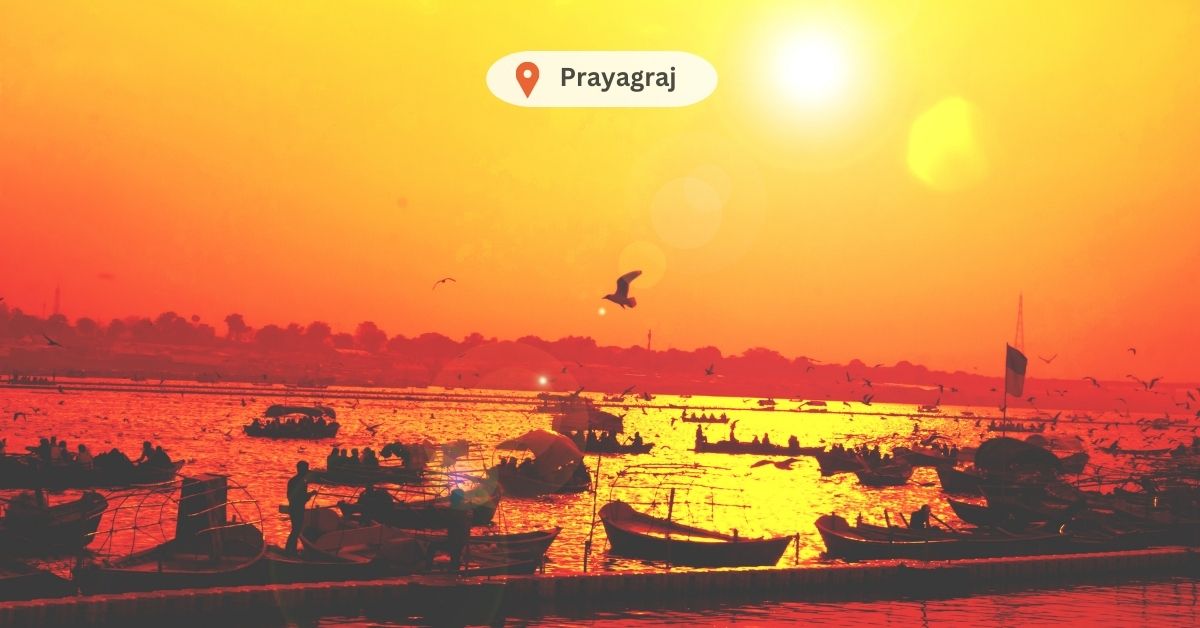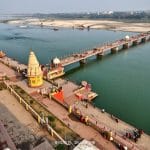Introduction to Kumbh Mela Prayagraj 2025
Kumbh Mela Prayagraj 2025 – Pilgrim’s Guide : Are you ready to witness humanity’s largest gathering of faith and devotion? Kumbh Mela Prayagraj 2025 promises to be an unprecedented spiritual spectacle, drawing over 200 million pilgrims from across the globe to experience the most sacred confluence of rivers in Hindu tradition. This extraordinary event transcends mere religious observance – it represents a living testament to India’s eternal spiritual heritage and the transformative power of collective devotion that has persisted for over two millennia.

The upcoming Kumbh Mela 2025 offers a once-in-a-lifetime opportunity to immerse yourself in authentic Hindu spirituality on an unimaginable scale. Picture yourself among millions of devoted souls, participating in ancient rituals unchanged since Vedic times, witnessing the spontaneous creation of the world’s largest temporary city, and experiencing spiritual energy so intense that visitors often describe it as life-transforming.
This comprehensive pilgrim’s guide provides everything necessary to navigate the complexities of Kumbh Mela Prayagraj 2025 while maximizing your spiritual and cultural experiences. From understanding the cosmic significance of sacred bathing dates to securing appropriate accommodations, from participating in akshayavat darshan to designing your perfect prayagraj kumbh itinerary, we’ll help you plan an unforgettable journey into the heart of Hindu civilization.
Whether you’re a seasoned spiritual practitioner, cultural enthusiast, or curious traveler seeking authentic experiences, Kumbh Mela 2025 offers transformative encounters that resonate throughout your lifetime. The sheer magnitude of devotion, intensity of spiritual atmosphere, and profound sense of universal brotherhood that emerges during this gathering creates memories that participants cherish as pivotal life experiences.
The logistical challenges of attending such a massive gathering require careful planning and expert guidance. Professional kumbh mela packages ensure meaningful participation while managing practical complexities that could otherwise overwhelm individual travelers attempting to navigate this extraordinary event independently.
Understanding the Sacred Significance of Kumbh Mela
Kumbh Mela derives its profound spiritual significance from ancient Hindu cosmology and mythology that describe the cosmic battle between gods and demons over the nectar of immortality (amrit). According to sacred texts, drops of this divine nectar fell at four locations across India – Prayagraj, Haridwar, Ujjain, and Nashik – creating the world’s most powerful pilgrimage destinations.
The astronomical calculations determining Kumbh Mela timing align with cosmic cycles that traditional Hindu understanding recognizes as optimal periods for spiritual advancement and karmic purification. These precise calculations, based on planetary positions and lunar cycles, occur approximately every twelve years, making each Kumbh Mela a rare cosmic opportunity.
Prayagraj holds supreme position among the four Kumbh locations due to its Triveni Sangam – the sacred confluence where Ganges, Yamuna, and mystical Saraswati rivers merge. This triple convergence creates amplified spiritual energy that devotees believe multiplies purification benefits exponentially compared to ordinary pilgrimage sites.
The communal aspect of Kumbh Mela demonstrates Hinduism’s emphasis on collective spiritual practice and social harmony. The temporary spiritual community that emerges during the festival showcases humanity’s capacity for peaceful coexistence while pursuing shared spiritual goals across diverse cultural, linguistic, and social boundaries.
Ancient scriptures promise extraordinary spiritual benefits for Kumbh Mela participation, including liberation from karmic bondage, accelerated spiritual progress, and divine grace that can transform consciousness permanently. These traditional beliefs continue motivating millions of contemporary pilgrims to undertake challenging journeys for Kumbh participation.
Kumbh Mela 2025 Dates and Astronomical Significance
Kumbh Mela Prayagraj 2025 spans approximately 45 days from mid-January through early March, with specific dates determined by complex astronomical calculations that align lunar cycles, planetary positions, and solar transitions to create optimal spiritual conditions. The exact timing reflects thousands of years of Vedic astronomical knowledge applied to spiritual practice.
The festival officially begins with Makar Sankranti (January 14, 2025) when the sun enters Capricorn, marking the auspicious beginning of Uttarayana – the sun’s northward journey that traditional understanding considers favorable for spiritual activities and consciousness expansion.
Peak spiritual significance occurs during major bathing dates when cosmic alignments create maximum purification potential. These calculated dates attract millions of simultaneous pilgrims seeking optimal spiritual benefits through sacred confluence bathing during astronomically perfect moments.
The 2025 Kumbh coincides with particularly powerful planetary configurations that occur rarely in cosmic cycles. Traditional astronomical calculations indicate these alignments will enhance spiritual benefits throughout the festival period, making 2025 an especially significant year for serious spiritual practitioners.
Post-festival activities continue for weeks after official conclusion as pilgrims complete their spiritual practices and gradually disperse. This extended period provides opportunities for deeper spiritual integration and reflection on transformative experiences gained during intensive festival participation.
The Sacred Geography of Triveni Sangam
Triveni Sangam represents the geographical and spiritual heart of Kumbh Mela, where three sacred rivers create one of Hinduism’s most powerful energy centers. The visible confluence of Ganges’ golden-brown waters with Yamuna’s blue-green flow, plus the invisible presence of Saraswati, creates a natural temple where divine energies concentrate most intensely.
Each river embodies distinct spiritual qualities that converge at the Sangam to create unified divine energy. Ganges represents purification and spiritual knowledge, Yamuna symbolizes devotion and divine love, while Saraswati embodies wisdom and creative consciousness. Bathing where these energies merge provides comprehensive spiritual benefits unavailable at single-river locations.
The confluence’s physical geography changes seasonally as river levels fluctuate, creating different bathing areas and spiritual atmospheres throughout the Kumbh period. Understanding these variations helps pilgrims choose optimal timing and locations for their sacred bathing experiences.
Sacred texts describe specific areas within the confluence that offer particular spiritual benefits. Traditional knowledge identifies different sections for various spiritual purposes – ancestor worship, personal purification, divine blessing, and spiritual transformation – allowing pilgrims to customize their sacred bathing according to individual spiritual needs.
Modern infrastructure development has enhanced access to the confluence while preserving its sacred character. Temporary bridges, ghats, and facilities enable millions of pilgrims to approach the sacred waters safely while maintaining reverent atmosphere appropriate for such a holy location.
Complete Prayagraj Kumbh Itinerary Planning
3-Day Essential Spiritual Circuit
The minimum meaningful Kumbh experience requires careful planning to maximize spiritual encounters within limited timeframes. A well-designed three-day itinerary covers essential sacred sites, major spiritual activities, and cultural experiences while ensuring comfortable participation in core Kumbh traditions.
Day 1 focuses on arrival, orientation, and initial sacred bathing at Triveni Sangam during optimal timing. This foundational experience establishes spiritual connection with the confluence while providing cultural acclimatization to the festival’s intense atmosphere and massive scale.
Day 2 includes comprehensive sacred site visits covering Akshayavat darshan, Hanuman Temple worship, and Allahabad Fort exploration. These visits provide diverse spiritual experiences while demonstrating the historical and mythological layers that make Prayagraj uniquely sacred.
Day 3 emphasizes cultural immersion through ashram visits, spiritual discourse attendance, and traditional ceremony participation. This concluding day integrates spiritual experiences while providing educational context for continued spiritual development after Kumbh participation.
Express itineraries require professional coordination to ensure essential experiences receive adequate attention while managing logistical complexities that could otherwise overwhelm brief visits. Expert guidance maximizes spiritual encounters while minimizing time lost to navigation and planning difficulties.
7-Day Comprehensive Pilgrimage
Week-long participation allows comprehensive Kumbh experience including multiple sacred bathing opportunities, extensive sacred site exploration, meaningful cultural immersion, and adequate time for spiritual reflection and integration.
The extended timeframe accommodates natural spiritual rhythms where intensive activities alternate with contemplative periods, preventing spiritual overwhelm while ensuring deep engagement with Kumbh’s transformative potential.
Multiple bathing opportunities during different cosmic conditions provide varied spiritual experiences while demonstrating how astronomical influences affect spiritual atmosphere and purification benefits throughout the festival period.
Ashram visits and spiritual teacher encounters become meaningful with extended time, allowing development of spiritual relationships and deeper philosophical exploration that brief visits cannot accommodate.
Cultural program participation includes traditional music, dance, and arts that demonstrate the civilizational context supporting Hindu spiritual traditions while providing educational entertainment that enriches spiritual understanding.
15-Day Complete Kumbh Experience
Extended participation provides comprehensive immersion in Kumbh’s spiritual, cultural, and social dimensions while allowing natural absorption of transformative experiences that characterize successful pilgrimage.
The timeframe accommodates participation in multiple major bathing dates, providing comparative experiences of different cosmic energies and spiritual atmospheres throughout the festival’s evolution.
Deep cultural integration becomes possible through sustained interaction with spiritual communities, traditional practitioners, and fellow pilgrims from diverse backgrounds united in shared spiritual seeking.
Educational opportunities expand to include Sanskrit studies, philosophical discourse, meditation instruction, and traditional arts learning that provide tools for continued spiritual development after Kumbh conclusion.
Service opportunities through volunteer activities demonstrate spiritual principles while contributing to the massive community effort required to maintain the festival’s infrastructure and support millions of participants.
Month-Long Kalpvas Journey
Traditional kalpvas represents the most intensive Kumbh participation, involving month-long residence at the confluence while maintaining strict spiritual disciplines including daily sacred bathing, meditation, prayer, and austere living conditions.
Historical kalpvas practices create conditions for profound spiritual transformation through sustained spiritual environment, community support, and intensive devotional practices that ordinary life rarely permits.
Modern kalpvas adaptations accommodate contemporary comfort requirements while preserving essential spiritual elements that make extended spiritual residence meaningful and transformative for serious practitioners.
Community integration during extended residence provides deep insights into Hindu spiritual culture while creating lasting relationships with traditional practitioners and fellow spiritual seekers from diverse backgrounds.
The gradual spiritual deepening that occurs during month-long practice cannot be replicated through brief visits, making kalpvas the preferred option for serious spiritual practitioners seeking maximum transformation benefits.
Akshayavat Darshan – The Immortal Banyan Tree
Spiritual Significance of Akshayavat
Akshayavat, the legendary immortal banyan tree housed within Allahabad Fort, represents one of Hinduism’s most sacred natural sites where devotees believe the divine presence manifests through living vegetation. The tree’s mythological significance as eternal and indestructible makes it a powerful symbol of spiritual continuity and divine permanence.
Ancient texts describe Akshayavat as existing throughout cosmic cycles of creation and destruction, making it a tangible connection to divine eternality that transcends temporal existence. This mythological significance attracts pilgrims seeking blessings for longevity, spiritual permanence, and protection from life’s uncertainties.
The tree’s location within the historic fort creates unique synthesis between natural spirituality and architectural grandeur, demonstrating how sacred sites often integrate multiple dimensions of human experience – spiritual, historical, artistic, and cultural.
Traditional worship protocols acknowledge the tree as a conscious divine entity deserving respectful approach and appropriate offerings. Understanding these protocols ensures meaningful darshan that honors both spiritual significance and cultural traditions surrounding this ancient sacred site.
Scientific studies of the tree’s age and botanical characteristics add contemporary interest to ancient spiritual traditions while demonstrating how natural phenomena can inspire spiritual interpretation and religious practice across cultural boundaries.
Visiting Procedures and Timings
Akshayavat darshan requires coordination with fort authorities and security arrangements due to the tree’s location within a protected historical monument. Professional guidance ensures smooth access while respecting administrative procedures and cultural protocols.
Optimal visiting times align with traditional Hindu worship schedules while considering crowd patterns and weather conditions that affect comfortable darshan experiences. Early morning visits often provide peaceful atmosphere ideal for contemplative tree worship.
Security procedures reflect the tree’s dual significance as spiritual site and historical monument, requiring patient cooperation with administrative requirements while maintaining devotional focus appropriate for sacred darshan.
Group coordination becomes essential during Kumbh period due to enormous demand for akshayavat darshan combined with limited access capacity. Professional arrangement ensures meaningful visits while managing time constraints and crowd challenges.
Cultural preparation includes understanding tree worship traditions, appropriate offerings, and behavioral protocols that demonstrate respect while facilitating authentic spiritual experiences rather than mere tourist observation.
Rituals and Offerings at Akshayavat
Traditional offerings include water, flowers, fruits, and sacred threads that honor the tree’s divine presence while following protocols that have evolved through centuries of continuous worship practice. Understanding appropriate offering procedures enhances spiritual significance while demonstrating cultural respect.
Circumambulation (pradakshina) follows prescribed patterns that honor the tree’s sacred geometry while providing meditative focus for contemplative worship. Professional guidance ensures proper procedures while explaining symbolic significance.
Prayer recitation includes Sanskrit verses specifically associated with tree worship and longevity blessings. Basic instruction in pronunciation and meaning helps visitors participate meaningfully in traditional ceremonial elements.
Wish fulfillment traditions involve specific procedures for requesting divine blessings while making commitments for spiritual practice or charitable activities. Understanding these reciprocal relationships demonstrates mature spiritual engagement.
Photographic restrictions respect both spiritual sensitivities and administrative regulations while allowing appropriate documentation of this rare darshan opportunity at one of India’s most sacred natural sites.
Major Spiritual Sites and Sacred Locations
Triveni Sangam – The Holy Confluence
The sacred confluence represents Kumbh Mela’s spiritual epicenter where millions seek purification through bathing in divinely charged waters. Understanding the Sangam’s spiritual geography, bathing protocols, and cosmic significance ensures meaningful participation in this most sacred activity.
Different areas within the confluence offer varying spiritual experiences based on traditional knowledge about divine energies and optimal bathing conditions. Professional guidance helps pilgrims select appropriate locations while understanding ritual procedures and safety considerations.
Boat services provide unique perspectives on the confluence while offering comfortable access during peak crowd periods. These river approaches often provide more peaceful spiritual experiences while showcasing the Sangam’s natural beauty and spiritual atmosphere.
Timing considerations align personal bathing with astrologically optimal periods while balancing crowd conditions, weather factors, and individual spiritual preparedness. Expert coordination ensures meaningful sacred bathing during ideal conditions.
Cultural context includes understanding the theological significance of triple river convergence while appreciating the historical continuity of worship traditions that have sanctified this location for over two millennia.
Hanuman Temple – The Sleeping Deity
Prayagraj’s famous Hanuman Temple houses the unique reclining statue of Lord Hanuman that attracts devotees seeking strength, courage, and spiritual protection. The temple’s unusual iconography creates powerful devotional atmosphere that many find deeply inspiring and transformative.
The temple’s proximity to Triveni Sangam creates natural pilgrimage circuits where confluence purification prepares devotees for intensive Hanuman worship. This traditional sequence maximizes spiritual benefits while providing logical geographical progression through sacred sites.
Regular ceremonies including morning and evening aarti create vibrant community worship experiences with collective chanting, musical performances, and devotional energy that demonstrate Hindu spiritual traditions’ social dimensions.
Special festival programs during Kumbh intensify the temple’s spiritual atmosphere through extended ceremonies, cultural programs, and community celebrations that provide enhanced spiritual opportunities for serious devotees.
The temple’s architectural features and historical development reflect evolving devotional practices while maintaining core spiritual authenticity that continues attracting millions of annual pilgrims seeking divine blessings.
Allahabad Fort and Historical Sites
The historic Allahabad Fort, built by Emperor Akbar in 1583, houses multiple sacred sites including Akshayavat and Patalpuri Temple while demonstrating the cultural synthesis that characterizes Indian civilization’s development through different historical periods.
Fort exploration reveals layers of historical development spanning over four centuries while showcasing how Islamic architecture integrated with pre-existing Hindu sacred sites rather than replacing them entirely.
Archaeological significance includes ancient foundations, historical artifacts, and architectural evolution that provide tangible connections to India’s complex political and cultural history surrounding sacred geographical locations.
Administrative access requires coordination due to the fort’s status as protected monument combined with its active spiritual significance. Professional guidance ensures smooth visits while respecting both historical preservation and religious access needs.
Educational opportunities include guided tours that explain historical context while maintaining respect for continuing spiritual practices that make the fort a living religious site rather than mere historical monument.
Patalpuri Temple Complex
The mysterious underground Patalpuri Temple provides unique spiritual experiences within subterranean chambers that create powerful atmospheric conditions conducive to deep meditation and contemplative worship practices.
Access restrictions due to limited capacity and safety considerations require advance coordination and professional guidance to ensure meaningful temple visits during brief access windows available to general pilgrims.
The temple’s connection to ancient spiritual practices and legendary events provides historical depth that enriches contemporary worship while demonstrating continuity between mythological narratives and current religious practice.
Underground architecture creates distinctive spiritual atmosphere that many visitors find particularly conducive to introspective spiritual practices and meditative experiences that surface temples sometimes cannot provide.
Cultural significance within broader Hindu temple traditions demonstrates how sacred architecture adapts to geographical constraints while maintaining essential spiritual functions and devotional effectiveness.
Shankaracharya Ashrams and Akharas
The various ashrams and akharas (religious orders) that establish temporary presence during Kumbh provide opportunities to encounter diverse Hindu spiritual traditions while observing authentic spiritual practices maintained by traditional religious communities.
Akhara processions and ceremonies showcase different spiritual lineages while demonstrating the organizational complexity that enables peaceful coordination among diverse religious groups during massive gatherings.
Spiritual discourse opportunities at established ashrams provide access to traditional teachings and philosophical instruction from qualified spiritual teachers representing various Hindu traditions and practices.
Community interaction within ashrams demonstrates how spiritual institutions maintain cultural transmission while adapting to contemporary challenges facing traditional religious practice and community organization.
Educational value includes exposure to Sanskrit learning, traditional music, spiritual arts, and philosophical discussion that provide comprehensive cultural education alongside spiritual enrichment.
Sacred Bathing Dates and Rituals
Shahi Snan – Royal Bathing Ceremonies
Shahi Snan represents the most spectacular ceremonial bathing when various akharas (religious orders) process to the confluence in elaborate processions featuring traditional regalia, musical accompaniment, and thousands of participating saints and spiritual practitioners.
The hierarchical bathing sequence reflects traditional precedence among different spiritual orders while demonstrating organizational sophistication required to coordinate peaceful participation by diverse religious communities during peak spiritual periods.
Ceremonial timing aligns with optimal astrological conditions while accommodating logistical requirements for managing enormous processions and ensuring safety for millions of spectators and participants converging simultaneously.
Cultural significance extends beyond mere religious ceremony to encompass living demonstration of India’s spiritual diversity, organizational capabilities, and peaceful coexistence principles that enable complex multi-community cooperation.
Spectator opportunities require advance positioning and professional guidance due to enormous crowds attracted to witness these spectacular displays of traditional spiritual culture and community organization.
Main Bathing Dates 2025
Makar Sankranti (January 14, 2025) marks the festival’s auspicious beginning when astronomical transition creates optimal cosmic conditions for spiritual purification and consciousness transformation through sacred confluence bathing.
Mauni Amavasya (January 29, 2025) represents the most spiritually significant bathing opportunity when new moon energy combines with silence observance to create extraordinary purification potential for serious spiritual practitioners.
Basant Panchami (February 3, 2025) celebrates spring’s arrival while honoring Goddess Saraswati, making this date particularly auspicious for students, artists, and knowledge seekers participating in confluence worship.
Maghi Purnima (February 12, 2025) provides final major bathing opportunity during traditional Kumbh period, offering completion energy for spiritual practices undertaken throughout the festival duration.
Maha Shivratri (February 26, 2025) extends sacred bathing opportunities beyond official Kumbh dates, attracting Lord Shiva devotees seeking divine blessings through confluence purification during this most sacred Shaivite festival.
Ritual Procedures for Sacred Bathing
Traditional bathing procedures include purification prayers, intention setting, ancestral offerings, and thanksgiving ceremonies that transform simple river bathing into comprehensive spiritual practice with profound personal and cosmic significance.
Preparation rituals involve mental purification, appropriate dress, and spiritual readiness that ensures maximum benefit from sacred water contact while demonstrating proper respect for divine presence believed to concentrate at the confluence.
Timing coordination aligns personal bathing with astronomical optimal periods while considering practical factors like crowd density, weather conditions, and individual physical capabilities and spiritual preparedness.
Post-bathing ceremonies include charity distribution, spiritual vows, and community service that complete traditional pilgrimage protocols while integrating personal transformation with social responsibility and divine gratitude.
Professional guidance ensures proper ritual sequence while providing cultural explanation that transforms mechanical procedure following into meaningful spiritual engagement with ancient wisdom traditions.
Kumbh Mela Packages and Tour Options
Budget Pilgrimage Packages
Economical Kumbh packages provide essential spiritual experiences while maintaining affordability through shared accommodations, group transportation, and basic amenities that cover fundamental needs without unnecessary luxury expenses.
Basic itineraries include major sacred site visits, essential ceremony participation, and cultural orientation while focusing resources on spiritual activities rather than comfort amenities that don’t enhance religious significance.
Group travel arrangements reduce individual costs while creating pilgrim community atmosphere that enhances spiritual experience through shared devotion and mutual support during challenging festival conditions.
Accommodation options include simple tent sharing, dormitory arrangements, and community facilities that provide essential shelter while emphasizing spiritual purpose over material comfort preferences.
Transportation coordination includes group bus services, shared transfers, and coordinated movement that manages logistics efficiently while maintaining reasonable costs for budget-conscious spiritual seekers.
Premium Spiritual Experiences
Enhanced packages combine spiritual authenticity with improved comfort through better accommodations, personalized services, and exclusive access opportunities that provide meaningful spiritual experiences without physical hardship.
Premium accommodations include comfortable tents, private facilities, and convenient locations that support intensive spiritual activities while ensuring rest and preparation space for demanding spiritual schedules.
Expert guidance includes qualified spiritual instructors, cultural interpreters, and traditional practitioners who provide deep spiritual context while facilitating meaningful engagement with complex ceremonial and philosophical content.
Exclusive opportunities include private spiritual consultations, special ceremony access, and traditional teacher meetings that provide personalized spiritual instruction unavailable through standard group arrangements.
Cultural enrichment includes classical performances, traditional arts workshops, and philosophical discussions that demonstrate the civilizational context supporting Hindu spiritual practices while providing educational entertainment.
Luxury Kumbh Accommodations
Ultimate comfort packages provide luxury amenities while maintaining authentic spiritual atmosphere through carefully designed facilities that blend modern convenience with traditional spiritual environment and cultural authenticity.
High-end tent designs include spacious layouts, elegant furnishing, climate control, private bathrooms with hot water, and personalized service that creates resort-quality experiences within authentic Kumbh settings.
Exclusive facilities include private dining, spa services, cultural programming, and enhanced security that provide unprecedented comfort while ensuring meaningful spiritual participation and cultural engagement.
VIP access includes preferred positioning for major ceremonies, private transportation, and expedited services that maximize spiritual opportunities while minimizing time lost to logistics and crowd navigation.
All-inclusive services cover accommodation, meals, transportation, guided activities, and cultural programs while providing comprehensive spiritual experiences that eliminate all practical concerns and planning requirements.
International Pilgrim Services
Specialized international services address unique needs of overseas visitors including visa assistance, cultural preparation, language support, and adaptation guidance that ensures meaningful participation regardless of cultural background.
Cultural bridge-building includes comprehensive orientation, traditional etiquette instruction, and philosophical context that helps international visitors understand and appreciate complex spiritual practices and social customs.
Language support includes qualified interpreters, translated materials, and multilingual guides who ensure communication effectiveness while facilitating authentic cultural exchange and spiritual understanding.
Logistical assistance covers international travel coordination, customs procedures, health requirements, and administrative support that eliminates bureaucratic obstacles while ensuring legal compliance and safety.
Extended touring options include pre-Kumbh and post-Kumbh spiritual circuits that provide comprehensive Indian spiritual experience while maximizing international travel investment through diverse cultural and religious encounters.
Accommodation and Infrastructure
Government Tent City Arrangements
The government-organized tent city represents one of the world’s most impressive temporary urban developments, providing basic accommodation for millions through systematic infrastructure that includes utilities, sanitation, security, and administrative services.
Facility categories range from basic shelter to moderate comfort options while maintaining affordable pricing that ensures festival accessibility across economic boundaries and social backgrounds.
Infrastructure includes temporary roads, electricity distribution, water supply, waste management, and communication systems that create functional urban environment within weeks of construction.
Allocation systems prioritize vulnerable populations including elderly pilgrims, families with children, and physically challenged visitors while maintaining fair distribution that accommodates diverse community needs.
Quality maintenance includes regular cleaning, security patrols, and facility repairs that ensure decent living conditions while managing enormous capacity and intensive usage throughout the festival period.
Private Camping Solutions
Private operators provide enhanced accommodation options including better facilities, improved locations, and personalized services that cater to pilgrims seeking comfort while maintaining authentic spiritual atmosphere.
Tent varieties include family accommodations, group facilities, and individual arrangements with varying amenity levels that accommodate different comfort preferences and budgetary considerations.
Location advantages include proximity to sacred sites, convenient transportation access, and peaceful environments that support spiritual practice while avoiding some commercial areas’ noise and congestion.
Service levels include meal provision, housekeeping, security, and concierge assistance that eliminate daily maintenance concerns while allowing focus on spiritual activities and cultural experiences.
Booking procedures require advance planning and substantial deposits due to limited capacity and high demand, especially for premium locations and enhanced facility options during peak spiritual periods.
Heritage Hotels and Dharamshalas
Established accommodations in Prayagraj city provide comfortable alternatives to tent camping while requiring transportation to confluence areas for spiritual activities and ceremony participation.
Heritage properties offer cultural atmosphere and historical ambiance that complement spiritual experiences while providing modern amenities and reliable service standards expected by comfort-conscious travelers.
Dharamshala options provide traditional pilgrimage accommodation with spiritual atmosphere, community dining, and religious programming that enhance cultural immersion while maintaining economical pricing.
Advance reservations become critical during Kumbh period due to enormous demand and limited capacity in permanent accommodation facilities that cannot expand like temporary tent arrangements.
Transportation coordination becomes essential for city-based accommodation users who require reliable access to confluence areas for early morning spiritual activities and ceremony participation throughout festival duration.
Ashram and Monastery Stays
Spiritual institutions often accommodate serious practitioners seeking intensive spiritual environment with traditional facilities, community prayers, and guidance from qualified spiritual teachers and traditional practitioners.
Ashram life includes participation in daily spiritual routines, community service, and educational programs that provide comprehensive spiritual experience while demonstrating authentic traditional spiritual lifestyle.
Application procedures typically require advance inquiry and may include interviews or recommendations to ensure appropriate spiritual commitment and compatibility with community spiritual goals and practices.
Facility standards emphasize simplicity and spiritual atmosphere over material comfort while providing essential needs for extended spiritual residence and intensive spiritual practice participation.
Cultural immersion through ashram residence provides deep insights into Hindu spiritual traditions while creating opportunities for meaningful relationships with traditional spiritual communities and practitioners.
Transportation and Connectivity
Railway Services and Special Trains
Indian Railways implements massive infrastructure expansion for Kumbh Mela 2025 including special pilgrimage trains, additional services, temporary stations, and enhanced facilities that accommodate unprecedented passenger volumes from across India and neighboring countries.
Special Kumbh trains feature enhanced facilities including comfortable seating, meal services, cultural programs, and spiritual atmosphere that begin transformative experiences during transit while building pilgrim community connections.
Prayagraj Junction undergoes temporary expansion including additional platforms, improved passenger facilities, and specialized crowd management that efficiently processes millions of pilgrims throughout the extended festival period.
Advance booking becomes essential due to enormous demand, with special reservation quotas allocated for Kumbh travelers. Professional coordination helps secure appropriate train services while managing complex booking procedures.
Station amenities include temporary expansions, food courts, medical facilities, information centers, and pilgrim services that support comfortable transit while managing unprecedented passenger volumes efficiently.
Airport Connectivity and Flights
Bamrauli Airport receives enhanced operations during Kumbh Mela 2025 with expanded flight schedules, additional airlines, temporary facilities, and coordinated ground transportation that provide convenient access for domestic and international pilgrims.
Charter flight services from major Indian cities provide direct access while avoiding commercial flight limitations and price fluctuations that affect independent travel during peak demand periods.
Alternative airports in Varanasi, Lucknow, and Delhi provide additional options with coordinated ground transportation to Prayagraj, offering more flight choices while requiring extended surface travel to reach festival areas.
Airport transportation includes shuttle services, private transfers, and group coordination that connect air travelers with accommodation and spiritual activities while ensuring smooth transitions between different transport modes.
International access requires visa processing and cultural preparation that professional services coordinate while providing comprehensive support for overseas pilgrims navigating complex logistics and cultural adaptation.
Road Transportation Networks
Extensive highway improvements include temporary roads, expanded parking facilities, and traffic management systems that accommodate massive vehicle convergence while maintaining safety and reasonable travel efficiency.
Bus services include government and private operators with specialized Kumbh packages that combine transportation with accommodation and spiritual activity coordination for comprehensive pilgrimage solutions.
Private vehicle arrangements require advance planning due to severe parking limitations and traffic restrictions during peak periods. Alternative transportation and advance coordination become essential for successful vehicle-based visits.
Traffic management includes extensive diversions, coordinated timing, and patient cooperation that maintains vehicle flow while prioritizing pedestrian safety and spiritual activity access over transportation convenience.
Professional transportation coordination provides reliable solutions while managing complex logistics and ensuring safety throughout the challenging traffic conditions that characterize major festival periods.
Local Transportation within Kumbh
Internal transportation systems include shuttle services, designated walkways, electric vehicles, and specialized transport that help pilgrims navigate the vast temporary city while accessing diverse spiritual sites and cultural activities.
Walking remains the primary transportation mode within core spiritual areas, with well-marked routes, rest stations,





